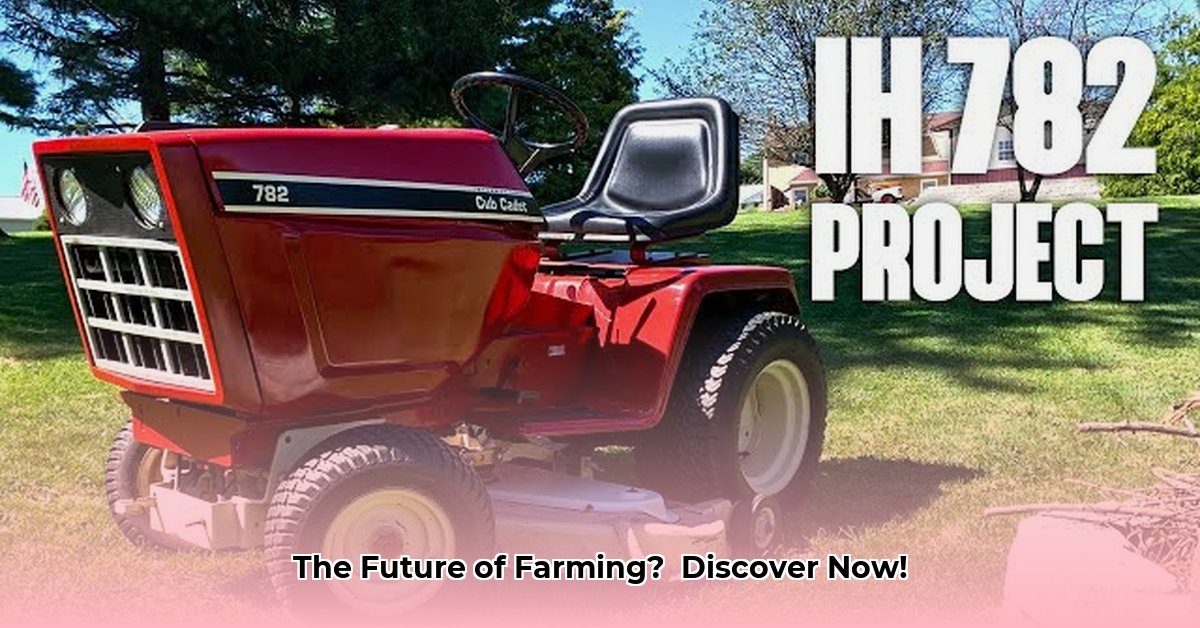
The Cub Cadet Legacy: A Surprisingly Green Story?
The humble garden tractor, a mainstay of suburban backyards and small farms alike, holds a surprisingly significant place in the narrative of sustainable agriculture. This story begins with International Harvester (IH) and its iconic Cub Cadet brand, whose evolution mirrors the broader shift towards environmentally conscious farming practices. While initially focused on raw power, the Cub Cadet's journey reflects a growing awareness of the environmental impact of agricultural machinery. But how significant has this impact truly been? For more compact tractor options, check out this link to subcompact tractors.
The sale of Cub Cadet to MTD in 1981 marked a pivotal moment. Did this transition, along with the subsequent closure of the Brownsville, Texas factory in 2009, accelerate or hinder progress toward sustainable manufacturing? Analyzing these historical shifts provides valuable insight into the evolving relationship between tractor production and environmental responsibility. This evolution isn’t solely about engine technology; it encapsulates the entire lifecycle of the machine, from material sourcing to end-of-life disposal.
Did you know that the average lifespan of a garden tractor can significantly impact its overall environmental cost? A well-maintained older model can contribute to sustainability by preventing unnecessary manufacturing and material consumption. But what about the environmental burden of its fuel consumption?
Sustainable Practices: Rethinking the Tractor's Footprint
Modern international garden tractor manufacturing demands a comprehensive approach to sustainability. It's no longer enough to simply focus on fuel efficiency; the entire production process must be examined. This includes:
Fuel Efficiency: The relentless pursuit of fuel-efficient engines is crucial. While significant progress has been made, further innovation in engine design and alternative fuels remains critical. How much fuel efficiency improvement have we actually seen over the last decade? Further research is needed to quantify this progress and identify areas for accelerated improvement.
Sustainable Materials: The incorporation of recycled materials and the exploration of plant-based composites are gaining traction. Are manufacturers prioritising these sustainable alternatives? Are there established metrics to measure the percentage of recycled content in new tractors? This data needs to be publicly accessible and transparent.
Cradle-to-Grave Analysis: A holistic understanding of a tractor's environmental impact requires assessing its entire lifecycle—from raw material extraction to final disposal. Currently, many manufacturers lack this comprehensive cradle-to-grave analysis. This needs to change, and industry-wide standards should be implemented.
"The lack of comprehensive lifecycle assessments is a significant obstacle to achieving true sustainability in agricultural machinery manufacturing," states Dr. Emily Carter, Professor of Chemical and Biomolecular Engineering at Princeton University. "We need standardized metrics to compare the environmental impact of different tractor models across their entire lifespan."
International Garden Tractors and Sustainable Farming: A Symbiotic Relationship
International garden tractors, particularly the Cub Cadet line, have played a pivotal role in enabling sustainable agricultural practices on smaller farms. Their compact size and maneuverability allow for precise operations, minimizing soil compaction and fuel consumption compared to larger machinery. However, the sustainability of these tractors themselves is dependent on several factors:
Government Incentives: Government policies—such as tax credits for fuel-efficient models or subsidies for recycled material usage—can drastically accelerate the adoption of sustainable technologies.
Technological Innovation: Ongoing research and development in areas like alternative fuels (biofuels, hydrogen), improved battery technology for electric models, and advanced manufacturing processes are vital for minimizing environmental impact.
Consumer Demand: Consumer preference for sustainable products exerts significant pressure on manufacturers to prioritize environmentally friendly designs and production methods. Increased demand for sustainable tractors will, in turn, drive innovation and competition.
How to Choose a Sustainable Lawn Tractor for Your Farm
Key Considerations:
- Assess your needs: Identify your key farm tasks and prioritize essential capabilities. Do you primarily require mowing, tilling, or other specialized functions?
- Prioritize Efficiency: Compare fuel efficiency ratings across different models. Consider the long-term cost of fuel consumption over the tractor's lifetime.
- Research Lifespan Costs: Calculating the total cost of ownership (including maintenance, repairs, and potential replacement costs) will help make an informed decision.
- Evaluate Versatility: Select a model with versatile attachment options to maximize efficiency and reduce the need for multiple specialized machines.
- Verify Sustainability Claims: Scrutinize manufacturer claims and look for third-party certifications attesting to sustainable manufacturing practices.
The Future of Sustainable Small Farm Tractors: A Path Forward
The future of sustainable small farm tractors hinges on a collaborative effort involving manufacturers, policymakers, researchers, and consumers. Investing in research and development, implementing supportive policies, and making informed purchasing decisions are all crucial steps towards a greener future. The transformation towards complete sustainability is an ongoing process, requiring continuous innovation and responsible practices throughout the entire lifecycle of these vital machines. The legacy of the International Harvester garden tractor, and especially Cub Cadet, should be one of both efficiency and environmental stewardship.